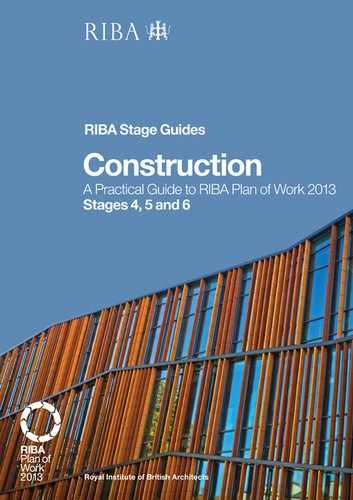Series editor’s foreword
The RIBA Plan of Work Stage Guides are a crucial accompaniment to the RIBA Plan of Work 2013. The plan’s format cannot communicate or convey the detail behind every term in the plan and this series provides essential guidance by considering, in depth, the reasoning and detail behind many new and reinvigorated subjects linking these to practical examples. The series is comprised of three titles which each concentrate on distinct stages in the Plan of Work. The first is Briefing by Paul Fletcher and Hilary Satchwell which covers Stages 7, 0 and 1. The second is Design by Tim Bailey and this covers Stages 2 and 3. The third is Construction by Phil Holden and covers Stages 4, 5 and 6. Subjects explored include how to assemble the most appropriate and effective project team and how to develop the best possible brief. The series also considers how to deal with the cultural shifts arising from a shift from “analogue” to transformational “digital” design processes as our industry begins to absorb the disruptive technologies that are changing many different and diverse sectors beyond recognition.
The RIBA Plan of Work 2013 drives a shift towards richer and bigger data which can be harnessed to create better whole life outcomes and thus significant additional benefits to clients and users. The first book in the series, Briefing, considers how the new project stages (0 and 7) will add value over the lifetime of a project as greater emphasis is placed on more resilient designs where whole life considerations are embedded into the early design stages. With this in mind the series emphatically starts with Stage 7 placing emphasis on the importance of learning from previous projects via feedback and in the future via data analytics. This initial chapter also sets out how post occupancy and building performance evaluations can be harnessed to inform the Business Case during Stage 0 underlining that big data will provide paradigm shifts in how to extract feedback from newly completed or existing projects, including historic buildings, to help better decision making in the early project stages.
More specifically, Paul and Hilary’s book considers new Stage 7 to 0 activities that will result in exciting new services in the future. These will ensure that the client’s brief is robust and properly considered providing the best possible platform for the design stages. This publication also considers the importance of site appraisals at Stage 0 and how Feasibility Studies can assist and add value at Stage 1 to the briefing process before the design process commences in earnest at Stage 2. In every stage there is added emphasis around Information Exchanges and the importance of considering who does what when at the outset of a project.
Although the core design stages (2 and 3) have not significantly changed, Tim Bailey’s book, Design, looks at how they might be adjusted and better focused to provide greater client emphasis at Stage 2 allowing the lead designer to take centre stage at Stage 3. During this stage greater emphasis is placed on the production of a co-ordinated design: the design team should be focused on the work required to verify that the Concept Design is robust and suitable for making a Planning application. In both stages new methods of communicating the progressing design create exciting new opportunities but at the same time require an examination of how to effectively manage the design process using tools such as the Design Programme to manage what is an iterative process.
Finally, Phil Holden’s book, Construction, considers the complexities of Stage 4 which is “sliced and diced” in different ways depending on the procurement route and the extent of design work undertaken by the specialist subcontractors employed by the contractor. He considers how the Design Programme for this change might alter to reflect different procurement routes and how this stage typically overlaps with construction (Stage 5). Handing over projects is becoming increasing complex and users now realise that the handover process can impact on successful operation and use of their buildings. Phil considers how the handover process is changing, placing greater emphasis on the user’s needs. His Stage 6 narrative considers how building contracts might adapt to this new environment placing greater emphasis on whole life matters including achieving better project outcomes rather than focusing on the closure solely of contractual matters and construction defects.
Five project scenarios weave through the series providing some practical examples of how the different stages of the plan of work might be interpreted on projects of differing scales, sectors, complexity using different procurement routes, providing a consistent thread through all of the books.
In summary, the series provides excellent additional guidance on how to use the RIBA Plan of Work 2013 allowing anyone involved in the built environment to understand and use the plan more effectively with the goal of achieving better whole life outcomes.
